Ion Transport Mechanism in the Sub-Nano Channels of Edge-Capping Modified Transition Metal Carbides/Nitride Membranes
Abstract
1. Introduction
2. Materials and Methods
2.1. Materials and Chemicals
2.2. Fabrication of Membranes
2.3. Characterization of Membranes
2.4. Salt Flux for Mxene and STPP-MXene Membranes
2.5. Salt Permeability, Solubility, and Diffusivity Performance Tests
2.6. Calculations of Activation Energy of Membranes
3. Results and Discussions
3.1. Characterizations of Membranes
3.2. Salt Flux of MXene and Modified STPP-MXene Membranes
3.3. The Salt Permeability (Ps) and Diffusivity (Ds) of the Membranes
3.4. Calculation and Mechanism of Energy Barriers Around the Membranes
4. Conclusions
Author Contributions
Funding
Data Availability Statement
Conflicts of Interest
References
- Tian, S.; Pan, Q.; Li, H.; Sui, X.; Chen, Y. Two-dimensional material membrane fabrication: Progress and challenges. Curr. Opin. Chem. Eng. 2023, 39, 100900. [Google Scholar] [CrossRef]
- Liu, G.; Jin, W.; Xu, N. Two-Dimensional-Material Membranes: A New Family of High-Performance Separation Membranes. Angew. Chem. Int. Ed. 2016, 55, 13384–13397. [Google Scholar] [CrossRef]
- Xu, R.; Kang, Y.; Zhang, W.; Pan, B.; Zhang, X. Two-dimensional MXene membranes with biomimetic sub-nanochannels for enhanced cation sieving. Nat. Commun. 2023, 14, 4907. [Google Scholar] [CrossRef]
- Zhao, R.; Li, Y.; Mao, Y.; Li, G.; Croes, T.; Zhu, J.; You, X.; Volodin, A.; Zheng, J.; Van der Bruggen, B. Recycling the High-Salinity Textile Wastewater by Quercetin-Based Nanofiltration Membranes with Minimal Water and Energy Consumption. Environ. Sci. Technol. 2022, 56, 17998–18007. [Google Scholar] [CrossRef]
- Karahan, H.E.; Goh, K.; Zhang, C.; Yang, E.; Yıldırım, C.; Chuah, C.Y.; Ahunbay, M.G.; Lee, J.; Tantekin-Ersolmaz, Ş.B.; Chen, Y.; et al. MXene Materials for Designing Advanced Separation Membranes. Adv. Mater. 2020, 32, 1906697. [Google Scholar] [CrossRef]
- Huang, Z.; Ling Zhao, D.; Shen, L.; Lin, H.; Chen, C.; Xu, Y.; Li, B.; Teng, J.; Han, L.; Chung, T.-S. Mxenes for membrane separation: From fabrication strategies to advanced applications. Sci. Bull. 2024, 69, 125–140. [Google Scholar] [CrossRef]
- Meng, B.; Liu, G.; Mao, Y.; Liang, F.; Liu, G.; Jin, W. Fabrication of surface-charged MXene membrane and its application for water desalination. J. Membr. Sci. 2021, 623, 119076. [Google Scholar] [CrossRef]
- Ding, L.; Wei, Y.; Wang, Y.; Chen, H.; Caro, J.; Wang, H. A Two-Dimensional Lamellar Membrane: MXene Nanosheet Stacks. Angew. Chem. Int. Ed. 2017, 56, 1825–1829. [Google Scholar] [CrossRef]
- Pan, J.; Xia, F. Membrane separation assisted by subnanometer channels. Matter 2022, 5, 2526–2528. [Google Scholar] [CrossRef]
- Zhou, S.; Guan, K.; Fang, S.; Wang, Z.; Li, Z.; Xu, P.; Nakagawa, K.; Takagi, R.; Matsuyama, H. Nanochannel characteristics contributing to ion/ion selectivity in two-dimensional graphene oxide membranes. J. Membr. Sci. 2024, 689, 122185. [Google Scholar] [CrossRef]
- Ghanbari, R.; Wu, D.; Heynderickx, P.M. Fabrication of MXene-based membranes and their application in per- and polyfluorinated substances removal: Comparison with commercial membranes, challenges, and future improvements. Coord. Chem. Rev. 2025, 523, 216253. [Google Scholar] [CrossRef]
- Xiang, B.; Gong, J.; Sun, Y.; Yan, W.; Jin, R.; Li, J. High permeability PEG/MXene@MOF membrane with stable interlayer spacing and efficient fouling resistance for continuous oily wastewater purification. J. Membr. Sci. 2024, 691, 122247. [Google Scholar] [CrossRef]
- Ding, L.; Li, L.; Liu, Y.; Wu, Y.; Lu, Z.; Deng, J.; Wei, Y.; Caro, J.; Wang, H. Effective ion sieving with Ti3C2Tx MXene membranes for production of drinking water from seawater. Nat. Sustain. 2020, 3, 296–302. [Google Scholar] [CrossRef]
- Yan, Y.; Han, H.; Dai, Y.; Zhu, H.; Liu, W.; Tang, X.; Gan, W.; Li, H. Nb2CTx MXene Nanosheets for Dye Adsorption. ACS Appl. Nano Mater. 2021, 4, 11763–11769. [Google Scholar] [CrossRef]
- Sun, Y.; Xu, D.; Li, S.; Cui, L.; Zhuang, Y.; Xing, W.; Jing, W. Assembly of multidimensional MXene-carbon nanotube ultrathin membranes with an enhanced anti-swelling property for water purification. J. Membr. Sci. 2021, 623, 119075. [Google Scholar] [CrossRef]
- Zhu, X.; Liu, F.; Meng, L.; Gao, Q.; Wang, X.; Lou, M.; Xu, X.; Zhang, W.; Li, F.; Van der Bruggen, B. MXene Membranes Inserted with Tannic Acid Etched MOF Nanocrystals for Ultrafast Water Permeation: Elucidating the Water Transport Mechanism in Nanoconfined Interlaminar Channels. Nano Lett. 2025, 25, 2810–2819. [Google Scholar] [CrossRef]
- Jang, J.; Kang, Y.; Jang, K.; Kim, S.; Chee, S.-S.; Kim, I.S. Ti3C2TX-Ethylenediamine nanofiltration membrane for high rejection of heavy metals. Chem. Eng. J. 2022, 437, 135297. [Google Scholar] [CrossRef]
- Yu, C.; Nghiem, L.D.; Zou, L. Catalytic chitosan/MXene/GO nanocomposite membrane for removing dye and heavy metals. Desalination 2025, 594, 118313. [Google Scholar] [CrossRef]
- Qiu, M.; Shen, Z.; Xia, Q.; Li, X.; Huang, H.; Wang, Y.; Liu, Y.; Wang, Y. Metal-polyphenol cross-linked titanium carbide membranes with stable interlayer spacing for efficient wastewater treatment. J. Colloid Interface Sci. 2022, 628, 649–659. [Google Scholar] [CrossRef]
- Qu, K.; Dai, L.; Xia, Y.; Wang, Y.; Zhang, D.; Wu, Y.; Yao, Z.; Huang, K.; Guo, X.; Xu, Z. Self-crosslinked MXene hollow fiber membranes for H2/CO2 separation. J. Membr. Sci. 2021, 638, 119669. [Google Scholar] [CrossRef]
- Helal, M.I.; Sinopoli, A.; Gladich, I.; Tong, Y.; Alfahel, R.; Gomez, T.; Mahmoud, K.A. Understanding the swelling behavior of Ti3C2Tx MXene membranes in aqueous media. J. Mater. Chem. A 2024, 12, 30729–30742. [Google Scholar] [CrossRef]
- Jiang, J.; Bai, S.; Zou, J.; Liu, S.; Hsu, J.-P.; Li, N.; Zhu, G.; Zhuang, Z.; Kang, Q.; Zhang, Y. Improving stability of MXenes. Nano Res. 2022, 15, 6551–6567. [Google Scholar] [CrossRef]
- Lu, Z.; Wei, Y.; Deng, J.; Ding, L.; Li, Z.-K.; Wang, H. Self-Crosslinked MXene (Ti3C2Tx) Membranes with Good Antiswelling Property for Monovalent Metal Ion Exclusion. ACS Nano 2019, 13, 10535–10544. [Google Scholar] [CrossRef]
- Li, X.; Wang, Z.; Jing, X.; Li, X.; Wang, J.; Kang, M.; Zhao, Y.; Li, Q. Construction and effect of intramolecular hydrogen bond on solvent resistance of polymeric membranes and their application in impermeable membranes. J. Ind. Eng. Chem. 2022, 107, 302–312. [Google Scholar] [CrossRef]
- Li, Y.; Zhu, X.; Gao, Q.; Bai, Y.; Lou, M.; Huang, S.; Li, F.; Van der Bruggen, B. Regulating molecules/ions sieving channels of MXene-based membranes by edge-capping strategy. J. Membr. Sci. 2024, 712, 123236. [Google Scholar] [CrossRef]
- Huang, S.; Natu, V.; Tao, J.; Xia, Y.; Mochalin, V.N.; Barsoum, M.W. Understanding the effect of sodium polyphosphate on improving the chemical stability of Ti3C2Tz MXene in water. J. Mater. Chem. A 2022, 10, 22016–22024. [Google Scholar] [CrossRef]
- Natu, V.; Hart, J.L.; Sokol, M.; Chiang, H.; Taheri, M.L.; Barsoum, M.W. Edge Capping of 2D-MXene Sheets with Polyanionic Salts to Mitigate Oxidation in Aqueous Colloidal Suspensions. Angew. Chem. Int. Ed. 2019, 58, 12655–12660. [Google Scholar] [CrossRef]
- Azam, R.S.; Almasri, D.A.; Alfahel, R.; Hawari, A.H.; Hassan, M.K.; Elzatahry, A.A.; Mahmoud, K.A. MXene (Ti3C2Tx)/Cellulose Acetate Mixed-Matrix Membrane Enhances Fouling Resistance and Rejection in the Crossflow Filtration Process. Membranes 2022, 12, 406. [Google Scholar] [CrossRef]
- Wu, Y.; Ding, L.; Lu, Z.; Deng, J.; Wei, Y. Two-dimensional MXene membrane for ethanol dehydration. J. Membr. Sci. 2019, 590, 117300. [Google Scholar] [CrossRef]
- Xia, H.; Zhou, W.; Qu, X.; Wang, W.; Wang, X.; Qiao, R.; Zhang, Y.; Wu, X.; Yang, C.; Ding, B.; et al. Electricity generated by upstream proton diffusion in two-dimensional nanochannels. Nat. Nanotechnol. 2024, 19, 1316–1322. [Google Scholar] [CrossRef]
- DuChanois, R.M.; Heiranian, M.; Yang, J.; Porter, C.J.; Li, Q.; Zhang, X.; Verduzco, R.; Elimelech, M. Designing polymeric membranes with coordination chemistry for high-precision ion separations. Sci. Adv. 2022, 8, eabm9436. [Google Scholar] [CrossRef]
- Fu, J.; Xiao, S.; Cao, J.; Liang, Z.; Chen, J.; Jiang, Y.; Xing, M. Mass Transfer-Enhanced Photothermal Membranes with Synergistic Light Utilization for High-Turbidity Wastewater Purification. Angew. Chem. Int. Ed. 2024, 64, e202421800. [Google Scholar] [CrossRef]
- Xu, T.; Wu, B.; Li, W.; Li, Y.; Zhu, Y.; Sheng, F.; Li, Q.; Ge, L.; Li, X.; Wang, H.; et al. Perfect confinement of crown ethers in MOF membrane for complete dehydration and fast transport of monovalent ions. Sci. Adv. 2024, 10, eadn0944. [Google Scholar] [CrossRef]
- Xu, X.; Zhu, X.; Chen, J.; Zhang, X.; Wang, Z.; Li, F. Lithium complexing strategy based on host-guest recognition for efficient Mg2+/Li+ separation. Water Res. 2025, 274, 123100. [Google Scholar] [CrossRef] [PubMed]
- Zhai, X.; Wang, Y.-L.; Dai, R.; Li, X.; Wang, Z. Roles of Anion–Cation Coupling Transport and Dehydration-Induced Ion–Membrane Interaction in Precise Separation of Ions by Nanofiltration Membranes. Environ. Sci. Technol. 2022, 56, 14069–14079. [Google Scholar] [CrossRef]
- Shefer, I.; Peer-Haim, O.; Leifman, O.; Epsztein, R. Enthalpic and Entropic Selectivity of Water and Small Ions in Polyamide Membranes. Environ. Sci. Technol. 2021, 55, 14863–14875. [Google Scholar] [CrossRef] [PubMed]
- Li, Y.; Huang, S.; Wei, C.; Wu, C.; Mochalin, V.N. Adhesion of two-dimensional titanium carbides (MXenes) and graphene to silicon. Nat. Commun. 2019, 10, 3014. [Google Scholar] [CrossRef] [PubMed]
- Niu, G.; Zhang, M.; Wu, B.; Zhuang, Y.; Ramachandran, R.; Zhao, C.; Wang, F. Nanocomposites of pre-oxidized Ti3C2Tx MXene and SnO2 nanosheets for highly sensitive and stable formaldehyde gas sensor. Ceram. Int. 2023, 49, 2583–2590. [Google Scholar] [CrossRef]
- Shamaei, L.; Khorshidi, B.; Islam, M.A.; Sadrzadeh, M. Development of antifouling membranes using agro-industrial waste lignin for the treatment of Canada’s oil sands produced water. J. Membr. Sci. 2020, 611, 118326. [Google Scholar] [CrossRef]
- Lu, Y.; Zhang, M.; Chang, J.; Sikdar, A.; Wang, N.; An, Q.-F.; Yuan, J. Heterostructure membranes of high permeability and stability assembled from MXene and modified layered double hydroxide nanosheets. J. Membr. Sci. 2023, 688, 122100. [Google Scholar] [CrossRef]
- Xu, S.; Liu, C.; Jiang, X.; Wang, X.; Zhang, S.; Zhang, Y.; Wang, Q.; Xiong, W.; Zhang, J. Ti3C2 MXene promoted Fe3+/H2O2 fenton oxidation: Comparison of mechanisms under dark and visible light conditions. J. Hazard. Mater. 2023, 444, 130450. [Google Scholar] [CrossRef] [PubMed]
- Sadidi, M.; Hajilary, N.; Abbasi, F. Optimization of biofuel dehydration performance of PES/PEI/MXene membrane by response surface method. J. Environ. Chem. Eng. 2023, 11, 110946. [Google Scholar] [CrossRef]
- Parker, T.; Zhang, D.; Bugallo, D.; Shevchuk, K.; Downes, M.; Valurouthu, G.; Inman, A.; Chacon, B.; Zhang, T.; Shuck, C.E.; et al. Fourier-Transform Infrared Spectral Library of MXenes. Chem. Mater. 2024, 36, 8437–8446. [Google Scholar] [CrossRef] [PubMed]
- Werber, J.R.; Osuji, C.O.; Elimelech, M. Materials for next-generation desalination and water purification membranes. Nat. Rev. Mater. 2016, 1, 16018. [Google Scholar] [CrossRef]
- Liu, M.; Guo, H.; Luo, J.; Gui, X.; Xing, Y.; Cao, Y. Investigation on the effect of metal cation radius on montmorillonite hydration: Combining experiments with molecular dynamics simulation. Sep. Purif. Technol. 2025, 353, 128474. [Google Scholar] [CrossRef]
- Wang, Y.; Zhang, H.; Kang, Y.; Zhu, Y.; Simon, G.P.; Wang, H. Voltage-Gated Ion Transport in Two-Dimensional Sub-1 nm Nanofluidic Channels. ACS Nano 2019, 13, 11793–11799. [Google Scholar] [CrossRef]
- Zhang, W.; Zeng, C.; Zhang, M.; Zhao, C.; Chao, D.; Zhou, G.; Zhang, C. MXene Triggered Free Radical Polymerization in Minutes Toward All-Printed Zn-Ion Hybrid Capacitors and Beyond. Angew. Chem. Int. Ed. 2025, 64, e202413728. [Google Scholar] [CrossRef]
- Natu, V.; Sokol, M.; Verger, L.; Barsoum, M.W. Effect of Edge Charges on Stability and Aggregation of Ti3C2Tz MXene Colloidal Suspensions. J. Phys. Chem. C 2018, 122, 27745–27753. [Google Scholar] [CrossRef]
- Ren, C.E.; Hatzell, K.B.; Alhabeb, M.; Ling, Z.; Mahmoud, K.A.; Gogotsi, Y. Charge- and Size-Selective Ion Sieving Through Ti3C2Tx MXene Membranes. J. Phys. Chem. Lett. 2015, 6, 4026–4031. [Google Scholar] [CrossRef]
- Ding, S.; Dai, X.; Tian, Y.; Chen, J.; Wang, L.; Li, G.; Li, S.; Meng, A.; Li, Z. Study on synergy effect of hydrated ionic radius and oxidation state for pre-intercalated cations towards highly reversible magnesium ions batteries. Chem. Eng. J. 2023, 471, 144615. [Google Scholar] [CrossRef]

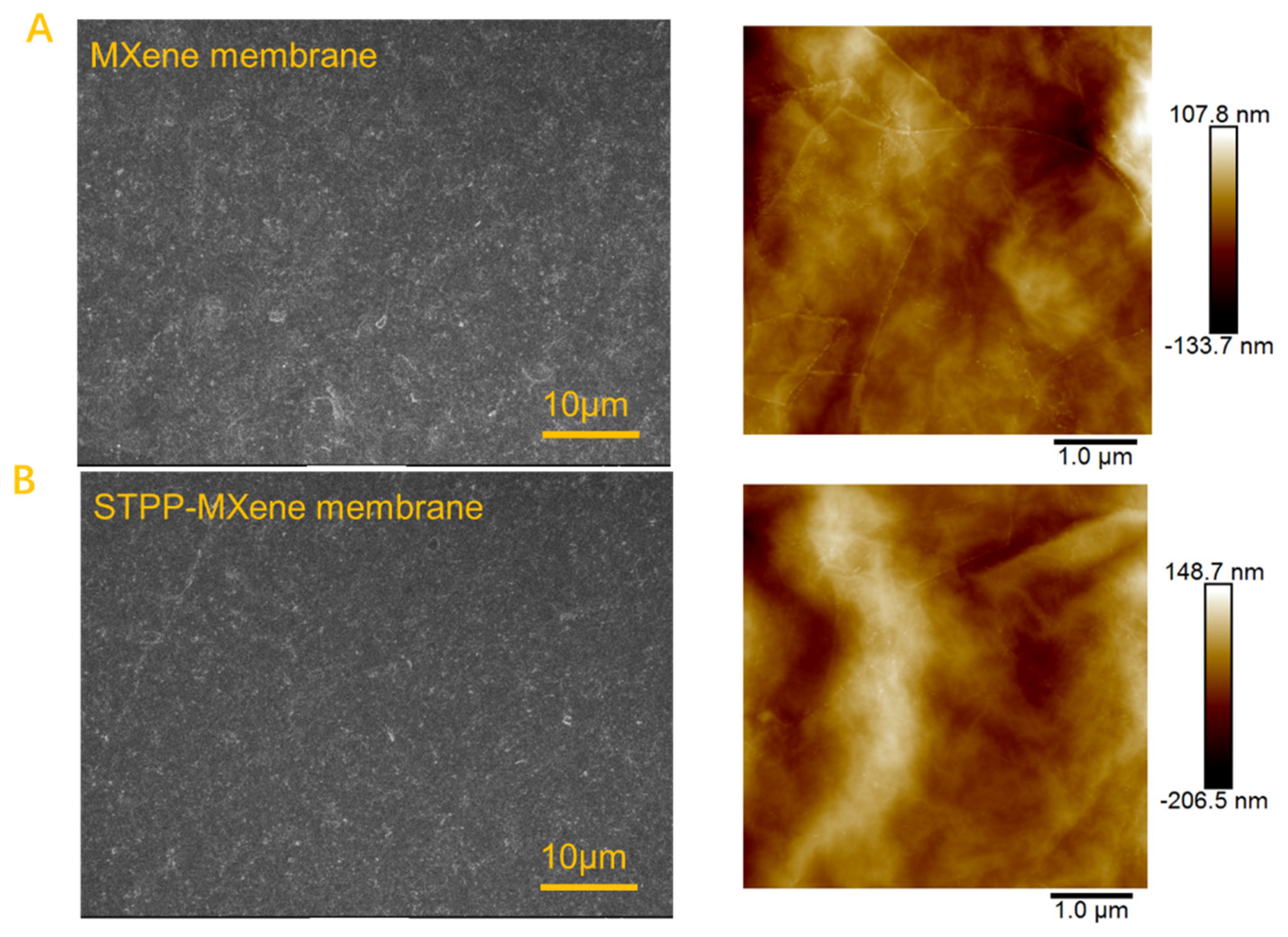
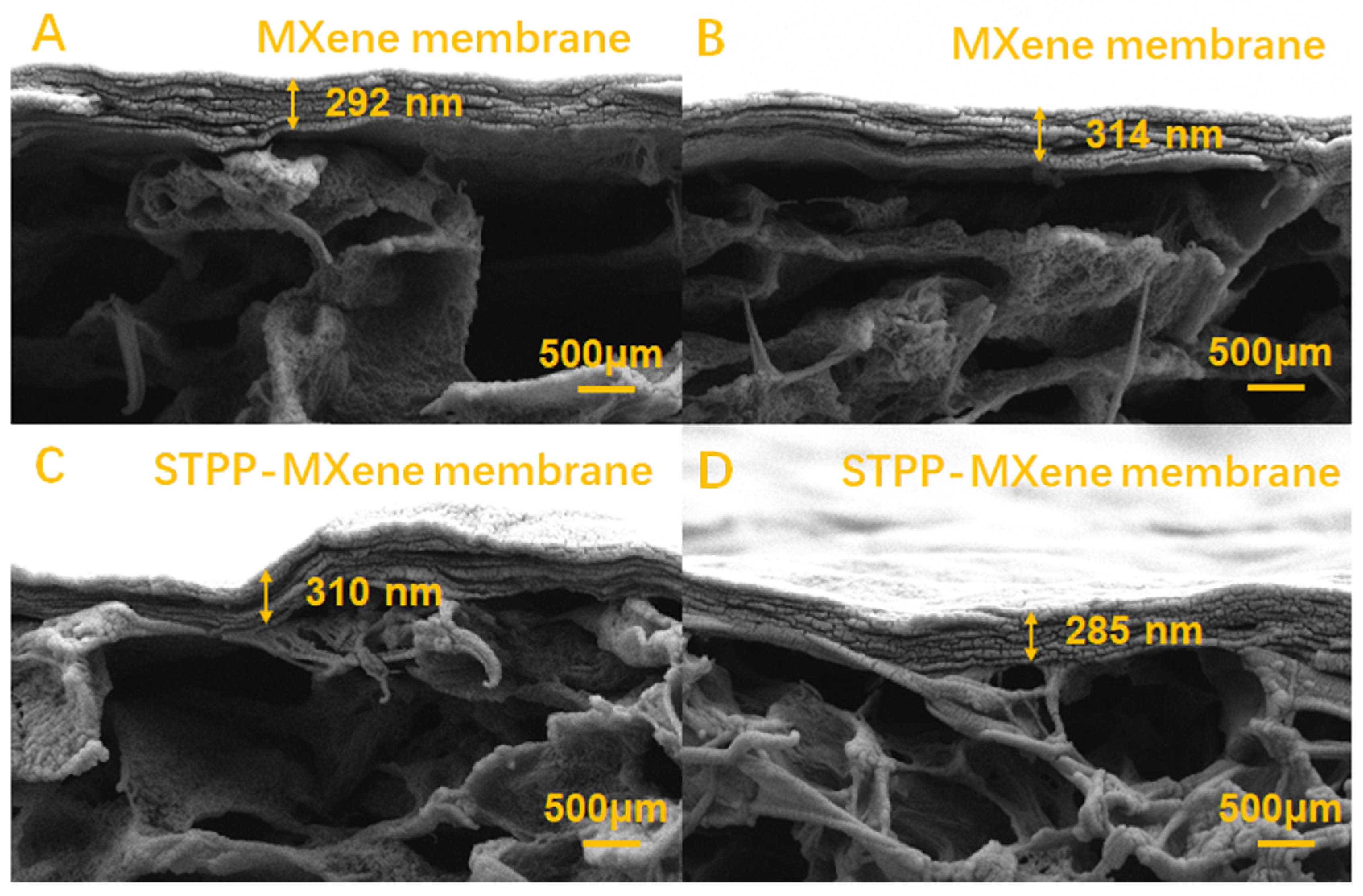
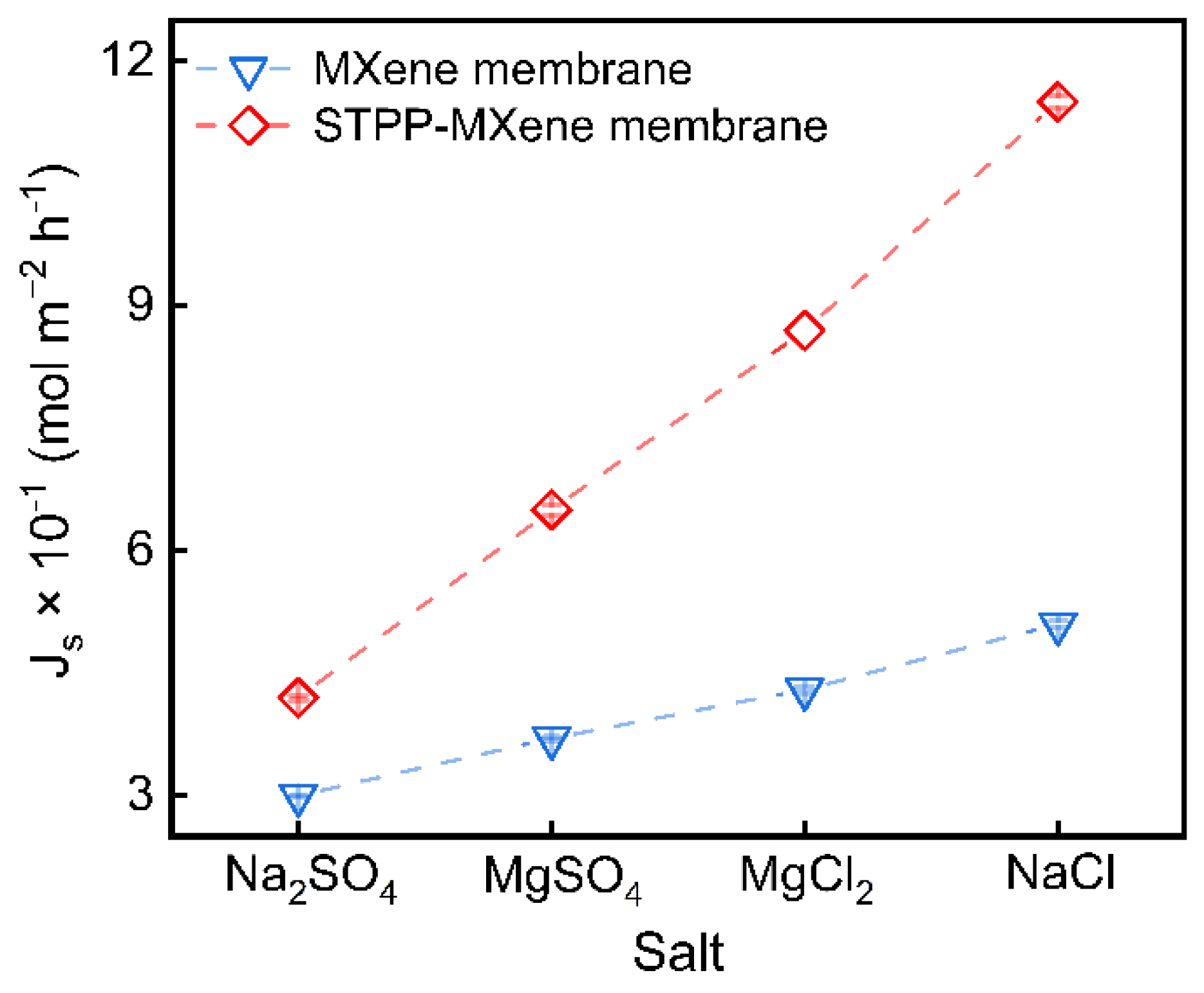
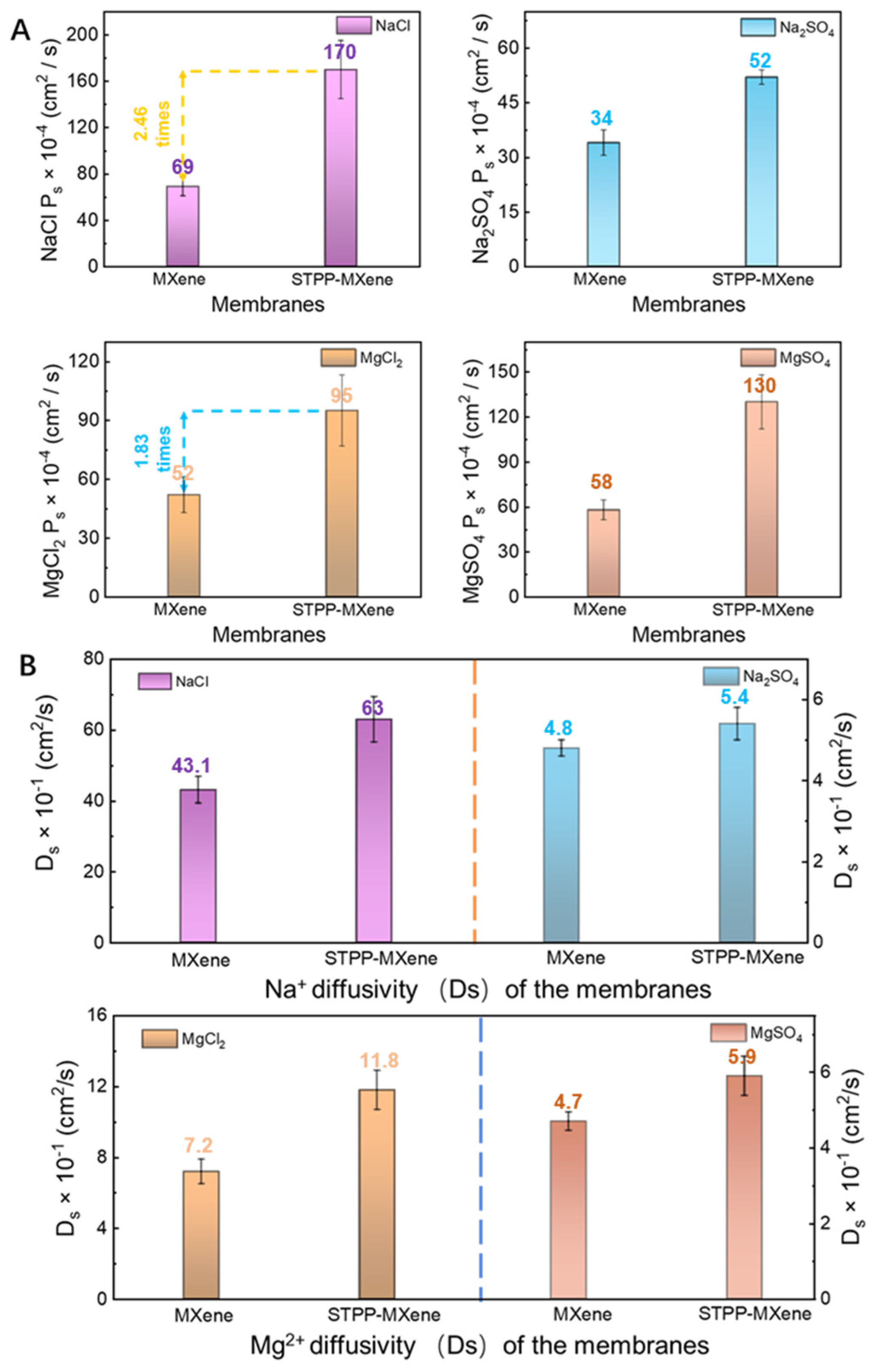
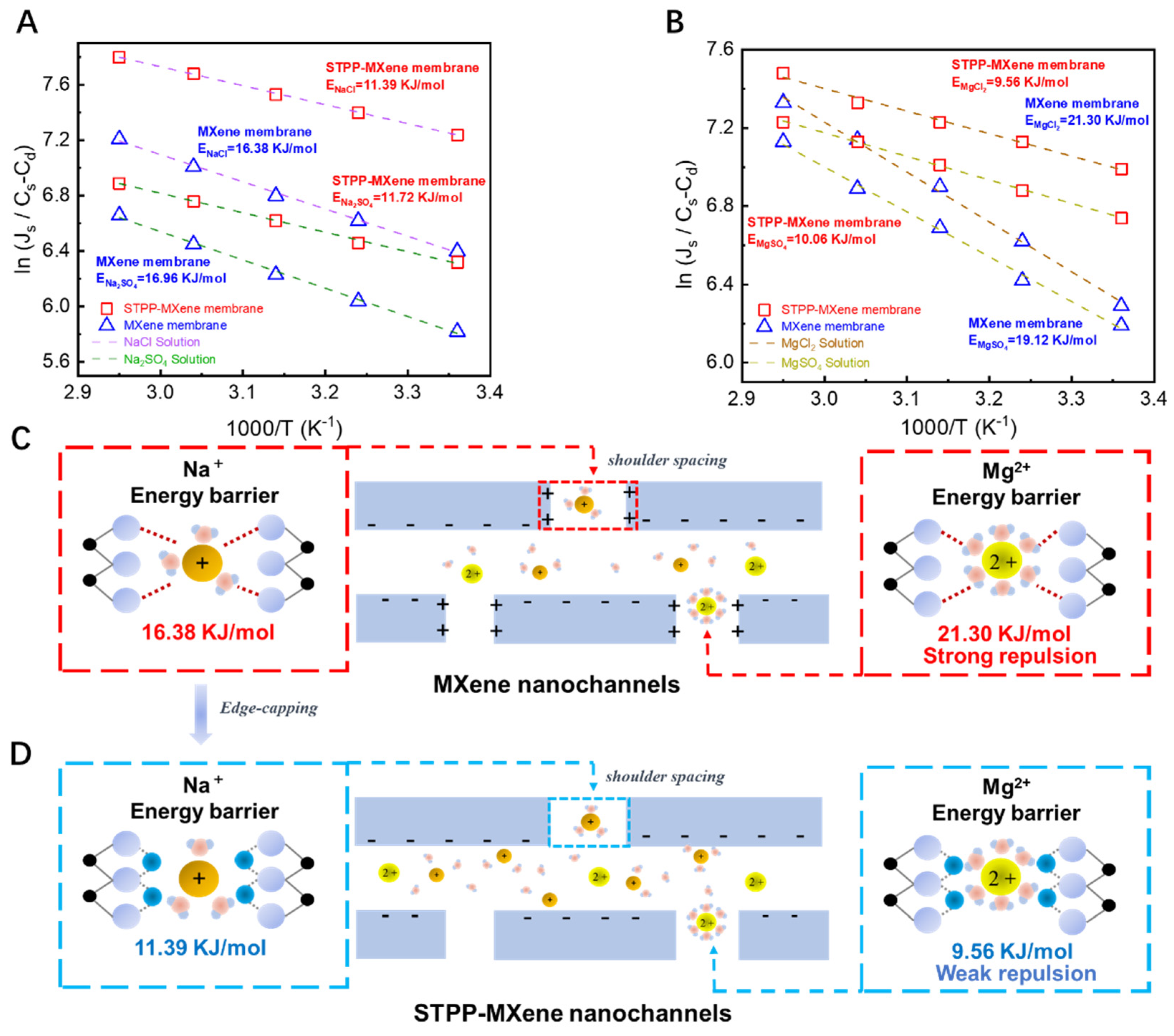
Disclaimer/Publisher’s Note: The statements, opinions and data contained in all publications are solely those of the individual author(s) and contributor(s) and not of MDPI and/or the editor(s). MDPI and/or the editor(s) disclaim responsibility for any injury to people or property resulting from any ideas, methods, instructions or products referred to in the content. |
© 2025 by the authors. Licensee MDPI, Basel, Switzerland. This article is an open access article distributed under the terms and conditions of the Creative Commons Attribution (CC BY) license (https://creativecommons.org/licenses/by/4.0/).
Share and Cite
Li, Y.; Xu, X.; Fang, X.; Li, F. Ion Transport Mechanism in the Sub-Nano Channels of Edge-Capping Modified Transition Metal Carbides/Nitride Membranes. Separations 2025, 12, 78. https://doi.org/10.3390/separations12040078
Li Y, Xu X, Fang X, Li F. Ion Transport Mechanism in the Sub-Nano Channels of Edge-Capping Modified Transition Metal Carbides/Nitride Membranes. Separations. 2025; 12(4):78. https://doi.org/10.3390/separations12040078
Chicago/Turabian StyleLi, Yinan, Xiangmin Xu, Xiaofeng Fang, and Fang Li. 2025. "Ion Transport Mechanism in the Sub-Nano Channels of Edge-Capping Modified Transition Metal Carbides/Nitride Membranes" Separations 12, no. 4: 78. https://doi.org/10.3390/separations12040078
APA StyleLi, Y., Xu, X., Fang, X., & Li, F. (2025). Ion Transport Mechanism in the Sub-Nano Channels of Edge-Capping Modified Transition Metal Carbides/Nitride Membranes. Separations, 12(4), 78. https://doi.org/10.3390/separations12040078




